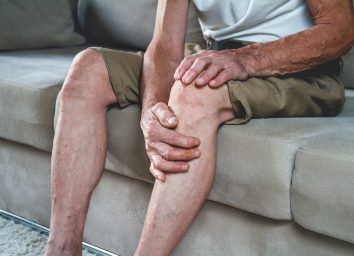Ugly Side Effects of Not Exercising at All, Say Leading Experts

It likely won't come as a shock to you to hear that leading a life lacking in physical activity won't do your body any favors. According to the Centers for Disease Control and Prevention (CDC), a sedentary lifestyle is one of the four pillars associated with avoidable chronic disease, alongside a poor diet, engaging in certain obvious nicotine-related habits, and alcohol abuse. The CDC also emphasizes that sedentary behavior is associated with "an estimated $117 billion" in healthcare costs every year.
If you've adopted a newly sedentary lifestyle in the wake of the events of the last year and a half—and if you're struggling to find your way back to a healthy, active lifestyle—know that you don't necessarily have to meet the U.S. Department of Health and Human Services' guidelines of 150 minutes to 300 minutes of moderate-intensity exercise every week starting right this second. You can start small. Simply walking for 20 minutes can do wonders for your body. If you're capable of performing intense exercises, one new study found that you can enjoy the benefits of exercise by working out for only 12 minutes in a week. If you're in the market for any number of workouts—be they walking, running, weightlifting, performing HIIT, or even simply stretching—simply check out our full bank of workouts right here.
If you don't, some bad things can happen to your body. For some ugly side effects associated with a lack of exercise, according to some of the nation's top doctors, read on. And for more on the risks of sitting too much, see here to learn why Sitting for This Long Is Dangerous As You Age, Says New Study.
You'll Be at Greater Risk of Heart Disease

Fact: Exercising regularly is great for your heart—period. According to the experts at John Hopkins Medical Center, moving more lowers your blood pressure—one of the major risk factors of heart disease—and it helps you slim down ("which in turn helps optimize heart health"), slows your risk of diabetes, helps you build your muscles and your aerobic capacity, and lowers your stress.
"Not getting enough physical activity can lead to heart disease—even for people who have no other risk factors," write the experts at the CDC. "It can also increase the likelihood of developing other heart disease risk factors, including obesity, high blood pressure, high blood cholesterol."
You'll Be at Greater Risk of Type-2 Diabetes

"Not getting enough physical activity can raise a person's risk of developing type 2 diabetes," says the CDC. "Physical activity helps control blood sugar (glucose), weight, and blood pressure and helps raise 'good' cholesterol and lower 'bad' cholesterol. Adequate physical activity can also help reduce the risk of heart disease and nerve damage, which are often problems for people with diabetes."
Simply walking after a meal can help you lower your diabetes risk. A 2013 study in the journal Diabetes Care found that walking generally helped improve blood sugar control. But people who took short, 15-minute walks after every meal saw even better blood glucose improvements than people who took a single 45-minute walk in the morning. Even a 10-minute walk after dinner can make a difference in blood sugar levels for people with type 2 diabetes, as shown in a 2016 Diabetologia study. Why? "Insulin secretion in response to a meal tends to wane later in the day," exercise science professor Loretta DiPietro told Time.
You'll Be at Greater Risk of Getting Several Cancers

"Getting the recommended amount of physical activity can lower the risk of many cancers, including cancers of the bladder, breast, colon, uterus, esophagus, kidney, lung, and stomach," says the CDC. "These effects apply regardless of weight status."
Here's How to Take Action

The experts at the CDC offer several tips for getting more movement into your daily life. Among them: Look for any way to reduce your sitting time ("for example, instead of watching TV, take a walk after dinner"), stick with activities you actually enjoy ("you might like morning walks in your neighborhood; others might prefer an online class after work"), and remind yourself that you can "break up" the guideline recommendations for 150 minutes of weekly exercise into "25 minutes a day every day." If you want even more great exercise tips, don't miss: The Secret Fitness Trick for Walking Better Starting Now, Say Experts.








